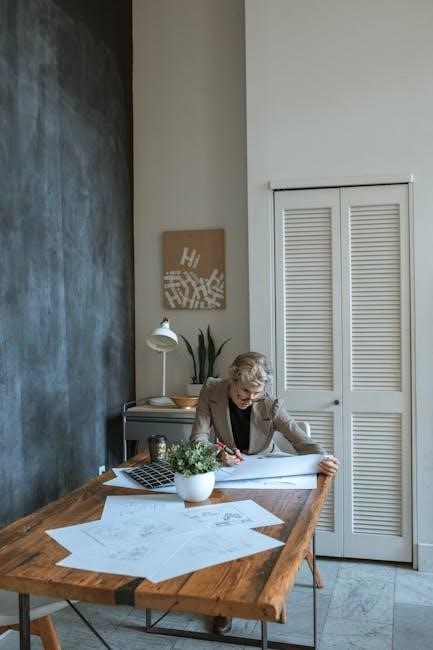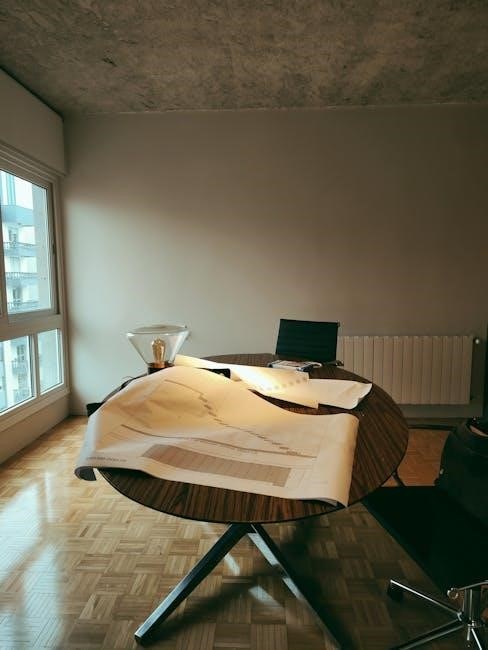free end table plans pdf
Free End Table Plans PDF: A Comprehensive Guide
Discover the world of DIY end tables with our comprehensive guide to free PDF plans. This resource offers a vast collection of styles, from rustic to modern, catering to all skill levels. Learn to build personalized end tables and save money by crafting unique pieces for your home.
The allure of crafting your own end tables lies in the blend of practicality, personalization, and the satisfaction of creating something with your own hands. In a world of mass-produced furniture, DIY end tables offer a unique opportunity to express your individual style and complement your living space with pieces that truly reflect your taste.
Embarking on a DIY end table project allows you to select the perfect dimensions, materials, and finishes to seamlessly integrate with your existing décor. Whether you’re drawn to the rustic charm of reclaimed wood, the sleek lines of modern design, or the cozy warmth of farmhouse aesthetics, the possibilities are endless.
Beyond aesthetics, building your own end table is a cost-effective way to furnish your home. By utilizing free PDF plans and sourcing materials strategically, you can save a significant amount compared to purchasing ready-made furniture. This allows you to invest in higher-quality materials or allocate your budget to other home improvement projects.

The process of building an end table is also a rewarding experience in itself. From the initial planning stages to the final finishing touches, you’ll gain valuable woodworking skills and a sense of accomplishment that comes with creating something tangible. With the help of readily available free plans and online tutorials, even beginners can successfully complete this project and add a personal touch to their homes.
Finding Free End Table Plans Online
The internet is a treasure trove of resources for DIY enthusiasts, and finding free end table plans is no exception. Numerous websites, woodworking communities, and online platforms offer a wide variety of plans in PDF format, catering to different skill levels and design preferences.
When searching for free plans, it’s essential to use specific keywords such as “free end table plans PDF,” “DIY side table plans,” or “woodworking plans for beginners.” This will help you narrow down your search and find relevant results. Explore websites dedicated to woodworking, home improvement, and DIY projects, as they often feature collections of free plans contributed by experienced woodworkers.

Online forums and communities are also valuable sources for finding free plans. Members often share their own designs, modifications, and tips, providing a collaborative environment for learning and inspiration. Platforms like Pinterest and woodworking blogs can also lead you to hidden gems and unique designs.
Before downloading any plan, carefully review the instructions, diagrams, and material lists to ensure they align with your skill level and available tools. Pay attention to the dimensions and overall design to determine if it suits your needs and aesthetic preferences. It’s also a good idea to read reviews or comments from other users who have built the project to gain insights and identify potential challenges.
Rustic End Table Plans
Rustic end tables bring a touch of natural charm and rugged appeal to any living space. Characterized by their use of reclaimed wood, distressed finishes, and simple, sturdy designs, these tables evoke a sense of warmth and authenticity. Free plans for rustic end tables often feature readily available materials like pallet wood, barn wood, or rough-sawn lumber, making them an affordable and eco-friendly option for DIY enthusiasts.
Common design elements in rustic end table plans include chunky legs, exposed joinery, and weathered surfaces. The use of natural stains or clear finishes allows the wood’s unique grain patterns and imperfections to shine through, adding to the table’s rustic character. Some plans may incorporate metal accents, such as wrought iron hardware or steel legs, for an added touch of industrial flair.
When selecting a rustic end table plan, consider the size and shape that best suits your needs and the overall aesthetic of your home. Square or rectangular tables with simple lines are a classic choice, while round or oval tables can add a softer, more organic feel; Look for plans that provide clear instructions, detailed diagrams, and a comprehensive list of materials and tools.
To enhance the rustic look, consider adding decorative elements such as vintage knobs, reclaimed hardware, or hand-painted details. A coat of wax or a distressed finish can further enhance the table’s aged appearance, creating a truly unique and charming piece of furniture.
Modern End Table Plans
Modern end table plans emphasize clean lines, geometric shapes, and minimalist designs, perfectly complementing contemporary living spaces. These plans often feature sleek surfaces, smooth finishes, and a focus on functionality without unnecessary ornamentation. Free modern end table plans are readily available online, catering to various skill levels and aesthetic preferences.
Key characteristics of modern end tables include the use of materials like plywood, MDF, or solid hardwoods with a preference for light or neutral tones. Metal accents, such as hairpin legs or geometric frames, are also common, adding a touch of industrial chic to the design. The emphasis is on creating a piece that is both visually appealing and practical.
When choosing a modern end table plan, consider the overall style of your room and select a design that complements your existing furniture. Simple, square or rectangular tables with clean lines are a popular choice, while more adventurous designs may incorporate asymmetrical shapes or unique geometric elements. Look for plans that provide detailed instructions, clear diagrams, and a comprehensive list of materials and tools.
To achieve a flawless modern look, pay close attention to the finishing details. A smooth, even paint job or a clear coat of varnish can enhance the table’s clean lines and highlight the natural beauty of the materials. Consider adding subtle accents, such as brushed metal hardware or a minimalist drawer pull, to complete the modern aesthetic.
End Tables with Drawers Plans
End tables with drawers offer a practical storage solution while enhancing the aesthetic appeal of any living space. Free end table plans with drawers are widely available online, catering to diverse styles and skill levels. These plans typically include detailed instructions for constructing the table frame, drawer box, and drawer front, along with hardware installation guidance.
Choosing the right plan involves considering the desired size, style, and complexity of the project. Simpler designs may feature a single drawer, while more elaborate plans can incorporate multiple drawers or hidden compartments. The drawer construction often involves basic joinery techniques like rabbets, dados, or dovetails, depending on the plan’s complexity.
Material selection is crucial for both aesthetics and functionality. Solid hardwoods like oak, maple, or cherry are popular choices for their durability and visual appeal. Plywood or MDF can be used for the drawer box to reduce cost and weight. Drawer slides, available in various types like ball-bearing or soft-close, ensure smooth and quiet operation.
When following end table plans with drawers, pay close attention to accurate measurements and precise cuts to ensure proper drawer fit and alignment. Proper sanding and finishing are essential for a professional-looking result. Consider adding decorative drawer pulls or knobs to complement the table’s overall style and enhance its functionality. These plans are perfect for adding hidden storage.
Simple End Table Plans for Beginners
For those new to woodworking, simple end table plans are an excellent starting point. These plans prioritize straightforward designs, basic joinery, and readily available materials, making the building process less daunting. Often, these beginner-friendly plans utilize common lumber like pine or poplar, which are affordable and easy to work with. The joinery typically involves butt joints, screws, and glue, minimizing the need for complex tools or advanced techniques.
A typical simple end table plan might feature a square or rectangular tabletop supported by four legs, with an optional lower shelf for added storage. The plans will include a detailed cut list, step-by-step instructions, and clear diagrams to guide beginners through each stage of the construction process. Emphasis is placed on accurate measurements and careful assembly to ensure a stable and functional end table.
Beginners should focus on mastering fundamental woodworking skills like measuring, cutting, sanding, and finishing. Practicing these skills on scrap wood before starting the actual project is highly recommended. Simple end table plans often encourage customization, allowing beginners to experiment with different finishes, paint colors, or hardware to personalize their creations.
Safety is paramount when working with power tools. Beginners should always wear appropriate safety gear, such as safety glasses and ear protection, and familiarize themselves with the safe operation of each tool before use. Starting with a simple end table project provides a solid foundation for future woodworking endeavors, building confidence and skills along the way.
Farmhouse Style End Table Plans
Farmhouse style end table plans evoke a sense of rustic charm and cozy simplicity, often incorporating distressed finishes, natural wood tones, and classic design elements. These plans typically feature sturdy construction, emphasizing functionality and durability. Common characteristics include planked tops, turned legs, and optional lower shelves or drawers for storage. The overall aesthetic is meant to feel warm, inviting, and slightly imperfect, reflecting the handcrafted nature of farmhouse furniture.
Many farmhouse style end table plans utilize reclaimed wood or materials with a weathered appearance to enhance the rustic feel. Techniques like distressing, sanding, and staining are employed to create a time-worn look. Popular wood choices include pine, oak, and maple, often finished with a matte or satin varnish to protect the surface while maintaining a natural aesthetic.
Free farmhouse style end table plans often include detailed instructions for creating decorative details such as breadboard ends, shiplap panels, or X-shaped accents. These elements add visual interest and contribute to the overall farmhouse aesthetic. Hardware choices also play a crucial role, with options like antique brass knobs, wrought iron pulls, and rustic hinges complementing the design.
Farmhouse style end tables are versatile pieces that can complement a variety of interior styles, from traditional to modern farmhouse. Their timeless appeal and practical design make them a popular choice for living rooms, bedrooms, and entryways. Building your own farmhouse style end table allows for customization to perfectly match your existing décor and personal preferences, creating a unique and cherished piece of furniture.
End Table Plans with Storage Solutions
End table plans with storage solutions offer a practical and stylish way to maximize space in any room. These designs incorporate drawers, shelves, or cabinets to provide convenient storage for books, magazines, remote controls, and other essentials. The integration of storage features enhances the functionality of the end table, making it a valuable addition to living rooms, bedrooms, and home offices.
Free end table plans with storage often include variations in drawer construction, from simple box joints to more intricate dovetail joints. Shelves can be open or enclosed, depending on the desired aesthetic and storage needs. Cabinet doors can be designed with solid panels, glass inserts, or decorative hardware to complement the overall style of the end table.
Many storage-focused end table plans incorporate creative storage solutions, such as built-in charging stations for electronic devices, hidden compartments for valuables, or pull-out trays for drinks and snacks. These innovative features add an extra layer of functionality and convenience to the end table.
When selecting end table plans with storage, consider the size and layout of your room, as well as your specific storage needs. Choose a design that complements your existing décor and provides ample storage without overwhelming the space. Building your own end table with storage allows for customization to perfectly fit your needs and preferences, creating a functional and stylish piece of furniture that enhances your living space.
Customizing Your End Table Plans

One of the greatest advantages of using free end table plans is the ability to customize them to your exact specifications. Whether you want to adjust the dimensions, change the materials, or add unique design elements, the possibilities are endless. Customization allows you to create a truly one-of-a-kind piece that perfectly complements your home décor and reflects your personal style.
Start by considering the size and shape of your desired end table. Adjust the dimensions of the plans to fit your specific space and needs. You can also experiment with different wood species to achieve the desired look and feel. Consider using reclaimed wood for a rustic aesthetic, or opt for hardwoods like oak or maple for a more refined appearance.

Don’t be afraid to modify the design elements of the end table. Add drawers, shelves, or cabinets for extra storage. Incorporate decorative details such as inlays, carvings, or metal accents. Experiment with different finishes to achieve the perfect color and sheen. You can also add personal touches such as family crests, monograms, or quotes.
When customizing your end table plans, remember to keep the overall design cohesive and balanced. Ensure that the modifications you make are structurally sound and do not compromise the integrity of the table. With a little creativity and ingenuity, you can transform a basic end table plan into a stunning and personalized piece of furniture that you’ll treasure for years to come.
Essential Tools and Materials
Embarking on your DIY end table project requires the right tools and materials for a successful build. Having these essentials on hand will ensure a smooth and efficient construction process. A well-equipped workshop is key to bringing your chosen free end table plan to life.
Essential Tools: A table saw is crucial for accurate and clean cuts of your wood pieces. A miter saw will aid in making precise angle cuts. A drill and driver set is necessary for creating pilot holes and securing screws. A sander, whether it’s an orbital or belt sander, will smooth out the surfaces for a professional finish. Clamps are indispensable for holding pieces together while glue dries.
Essential Materials: The type of wood you choose will greatly influence the look and feel of your end table. Pine is an affordable option for beginners, while hardwoods like oak or maple offer durability and a more refined aesthetic. Screws, nails, and wood glue are essential for joining the pieces together. Sandpaper in various grits will prepare the wood for finishing.
Finishing Materials: Choose a stain or paint to protect and enhance the beauty of the wood. Polyurethane or varnish will provide a durable and water-resistant finish. Brushes, rollers, and rags are needed for applying the finish. Safety glasses, a dust mask, and gloves are crucial for protecting yourself during the construction process.
Step-by-Step Construction Guide
Building your own end table can be a rewarding experience. This step-by-step guide provides a general framework, but always refer to your specific free end table plan PDF for detailed instructions and measurements. Safety should be your top priority throughout the construction process.
Step 1: Prepare the Wood: Begin by cutting all the wood pieces according to the dimensions specified in your plan. Ensure accurate cuts for a seamless assembly. Sand each piece thoroughly to remove any rough edges or imperfections.
Step 2: Assemble the Frame: Start assembling the main frame of the end table. Apply wood glue to the joints and secure them with screws or nails. Use clamps to hold the pieces together until the glue dries completely. Double-check for squareness to ensure a stable structure.
Step 3: Add the Tabletop: Attach the tabletop to the assembled frame. Use glue and screws to create a strong and secure connection. Ensure the tabletop is centered and aligned correctly.
Step 4: Finishing Touches: Fill any nail holes or imperfections with wood filler. Sand the entire end table smooth. Apply your chosen stain or paint, following the manufacturer’s instructions. Once the stain or paint is dry, apply a protective finish like polyurethane or varnish.
